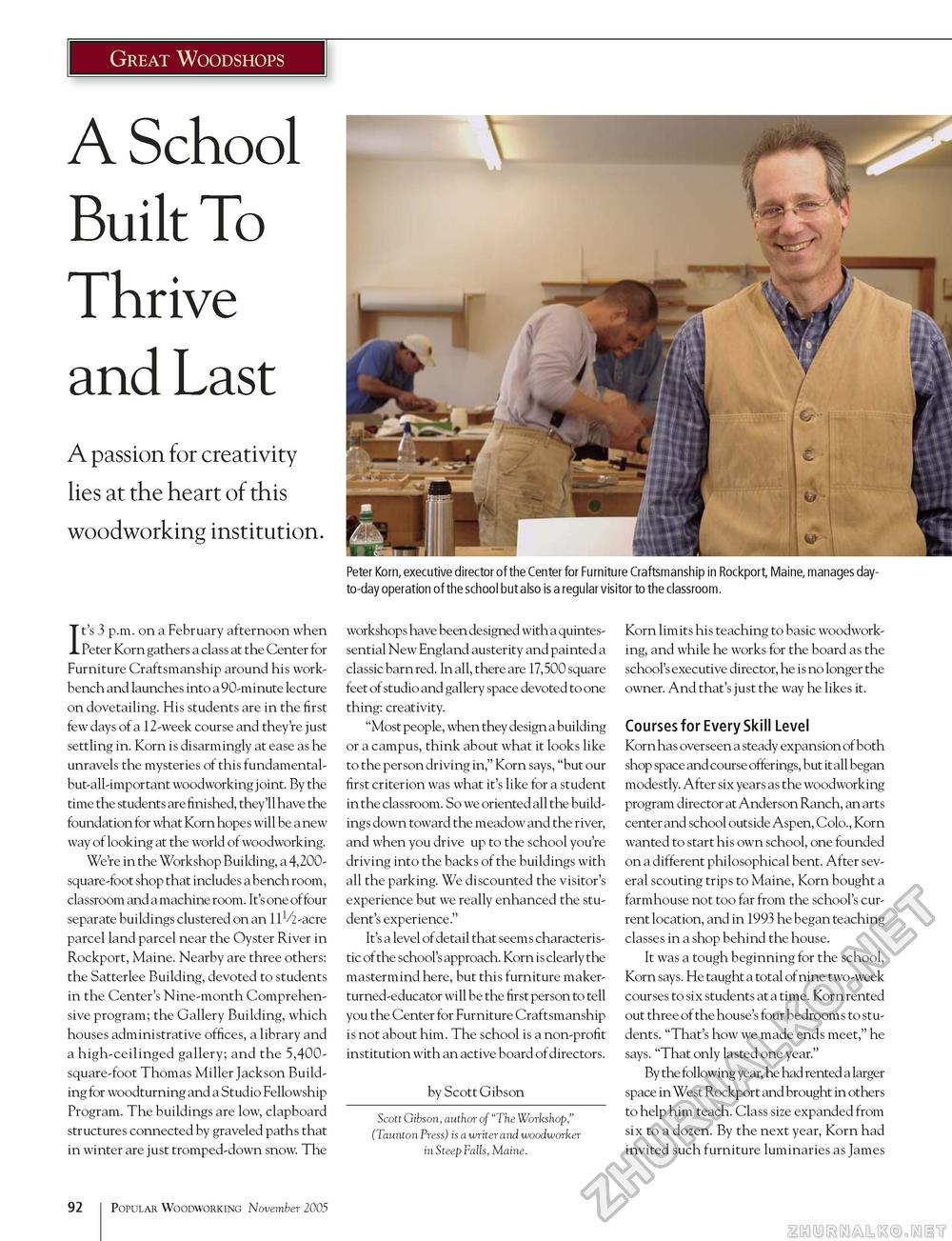Popular Woodworking 2005-11 № 151, страница 95
Great Woodshops A School Built To Thrive and Last A passion for creativity lies at the heart of this woodworking institution. It's 3 p.m. on a February afternoon when Peter Korn gathers a class at the Center for Furniture Craftsmanship around his workbench and launches into a 90-minute lecture on dovetailing. His students are in the first few days of a 12-week course and they're just settling in. Korn is disarmingly at ease as he unravels the mysteries of this fundamental-but-all-important woodworking joint. By the time the students are finished, they'll have the foundation for what Korn hope s will be a new way of looking at the world of woodworking. We're in the Workshop Building, a 4,200-square-foot shop that includes a bench room, classroom and a machine room. It's one of four separate buildings clustered on an 11/2 -acre parcel land parcel near the Oyster River in Rockport, Maine. Nearby are three others: the Satterlee Building, devoted to students in the Center's Nine-month Comprehensive program; the Gallery Building, which houses administrative offices, a library and a high-ceilinged gallery; and the 5,400-square-foot Thomas Miller Jackson Building for woodturning and a Studio Fellowship Program. The buildings are low, clapboard structures connected by graveled paths that in winter are just tromped-down snow. The Peter Korn, executive director of the Center for Furniture Craftsmanship in Rockport, Maine, manages day-to-day operation of the school but also is a regular visitor to the classroom. workshops have been designed with a quintessential New England austerity and painted a classic barn red. In all, there are 17,500 square feet of studio and gallery space devoted to one thing: creativity. "Most people, when they design a building or a campus, think about what it looks like to the person driving in," Korn says, "but our first criterion was what it's like for a student in the classroom. So we oriented all the buildings down toward the meadow and the river, and when you drive up to the school you're driving into the backs of the buildings with all the parking. We discounted the visitor's experience but we really enhanced the student's experience." It's a level of detail that seems characteristic of the school's approach. Korn is clearly the mastermind here, but this furniture maker-turned-educator will be the first person to tell you the Center for Furniture Craftsmanship is not about him. The school is a non-profit institution with an active board of directors. by Scott Gibson Scott Gibson, author of "The Workshop," (Taunton Press) is a writer and woodworker in Steep Falls, Maine. Korn limits his teaching to basic woodworking, and while he works for the board as the school's executive director, he is no longer the owner. And that's just the way he likes it. Courses for Every Skill Level Korn has overseen a steady expansion of both shop space and course offerings, but it all began modestly. After six years as the woodworking program director at Anderson Ranch, an arts center and school outside Aspen, Colo., Korn wanted to start his own school, one founded on a different philosophical bent. After several scouting trips to Maine, Korn bought a farmhouse not too far from the school's current location, and in 1993 he began teaching classes in a shop behind the house. It was a tough beginning for the school, Korn says. He taught a total of nine two-week courses to six students at a time. Korn rented out three of the house's four bedrooms to students. "That's how we made ends meet," he says. "That only lasted one year." By the following year, he had rented a larger space in West Rockport and brought in others to help him teach. Class size expanded from six to a dozen. By the next year, Korn had invited such furniture luminaries as James 92 Popular Woodworking November 2005 |








